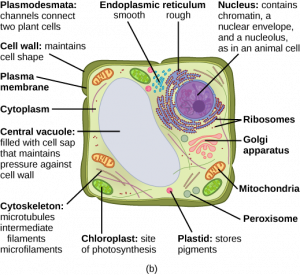The Cell Wall
The cell wall is a rigid covering that protects the cell, provides structural support, and gives shape to the cell. Cell walls are found in both prokaryotes and eukaryotes, although not all cells have cell walls. In Figure 1, the diagram of a plant cell, you see a structure external to the plasma membrane which is the cell wall. The cell wall is the reason why vegetables such as celery crunch when you bite into them.
Fungal and protist cells also have cell walls, but they are structurally different from those found in plants..

While the chief component of prokaryotic cell walls is peptidoglycan, the major organic molecule in the plant cell wall is cellulose, a polysaccharide made up of long, straight chains of glucose units. When nutritional information refers to dietary fiber, it is referring to the cellulose content of food. Fungal cell walls are made up of a molecule called chitin.
Animal cells do not have cell walls. Steak does not crunch when you bite it.
References
Unless otherwise noted, images on this page are licensed under CC-BY 4.0 by OpenStax.
Text adapted from: OpenStax, Concepts of Biology. OpenStax CNX. May 18, 2016 http://cnx.org/contents/b3c1e1d2-839c-42b0-a314-e119a8aafbdd@9.10

